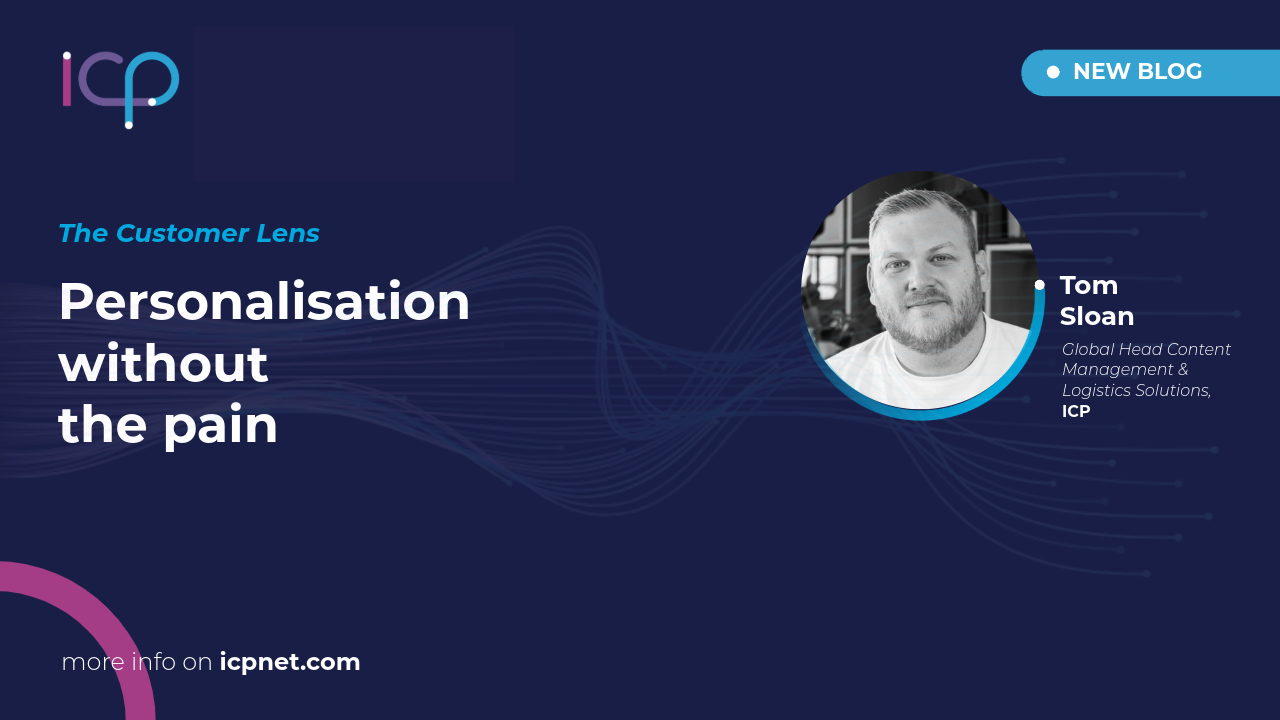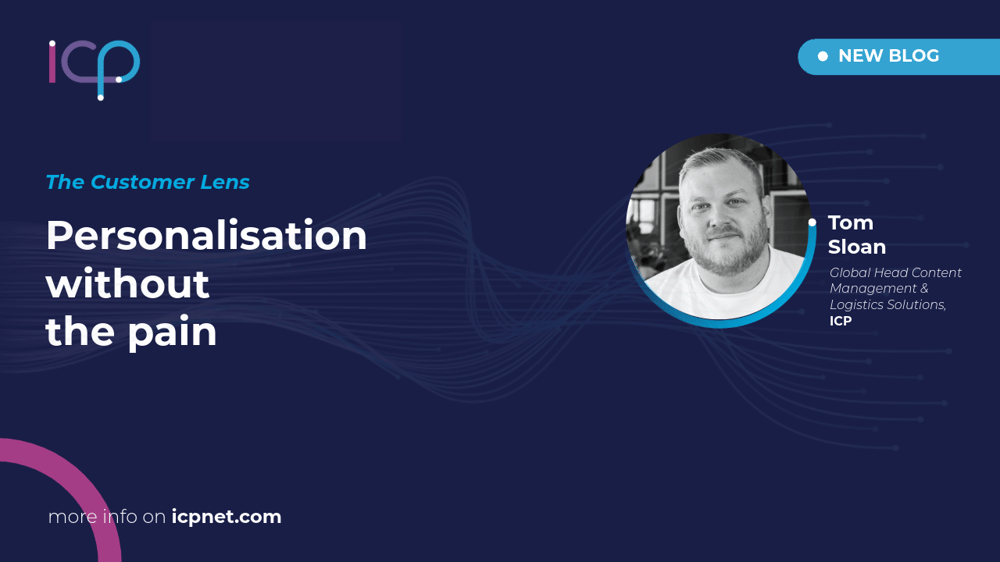

The Customer Lens: Personalisation without the pain
Consumers expect experiences that feel tailored, relevant, and seamless. Yet for most marketers, delivering personalisation at scale feels complex, costly, and time-consuming.
The impact is undeniable: personalised marketing can reduce customer acquisition costs by up to 50%, boost revenues by 5–15%, and raise ROI by 10–30% (McKinsey). And the backbone of this efficiency? Structured, AI-ready data. Real-world case studies show structured data leading to 3× conversion increases and 20% higher click-through rates, thanks to richer search visibility and relevance.
The solution isn't more content—it's smarter use of digital asset management (DAM), logistics, and AI. But as we'll explore, successful personalisation at scale requires more than just better content management. It demands a fundamental shift in how we think about data, content design, and customer understanding.
Why personalisation feels so complex
Marketers know personalisation is powerful, but most get stuck on execution. Challenges include:
- Fragmented content systems that don't talk to each other
- Manual metadata management that slows down delivery
- High production costs when teams try to scale content variations
- Difficulty proving ROI when data isn't connected across systems
This complexity breeds hesitation, but the urgency is real: consumers are gravitating to brands that make them feel seen, while cutting ties with those that can't keep up.
The missing foundations: data and design thinking
Personalisation at scale doesn’t start with technology alone. The brands getting it right have invested in two foundational capabilities that make DAM and AI deliver on their promise: data centralisation and content design evolution.
Data centralisation for customer understanding
True personalisation requires a single customer view — a unified data layer drawing from CRM systems, customer data platforms (CDP), product information management (PIM), commerce platforms, and behavioural signals from CMS and social channels.
This isn’t just plumbing. A unified view powers the segmentation frameworks and targeting logic that transform personalisation from a mechanistic exercise into something meaningful. The impact is clear: brands with centralised customer data see 2.3x higher customer lifetime value and 1.8x higher revenue growth compared to those with fragmented data (Salesforce).
Just as importantly, it removes the costly guesswork that leads to irrelevant campaigns and wasted media spend.
Content design evolution
The way content is created must also change. Traditional campaign-first production can’t keep pace with personalised marketing at scale. Instead, brands are adopting modular content design and experience mapping across customer journeys, decision states, and touchpoints.
Rather than producing finished assets in isolation, teams design reusable components — headlines, hero images, offers, CTAs — that can be dynamically assembled based on customer data and context.
The business impact is significant: modular content design can reduce production costs by up to 60% while increasing campaign variations by 10x. More importantly, it delivers genuinely personalised experiences rather than superficial “name-in-subject-line” messaging — resulting in 4x higher engagement rates and 2.5x stronger conversion performance.
These foundations fundamentally change the role of DAM. No longer just a repository, DAM becomes the orchestration engine that connects customer intelligence with modular content components that enable personalisation at scale.
The outcome? Brands can deliver hundreds of personalised variations without proportionally increasing costs, cut time-to-market by 50–70%, and achieve the kind of relevance that builds loyalty, not just clicks.
Where AI and DAM make the difference
With the right data foundations and modular content approach, AI can automatically recommend, adapt, and deliver the right content to the right customer—based on behaviour, demographics, or purchase history. Examples:
Marriott's AI-powered content agents at Adobe Summit 2025 generated millions of personalised variations, reducing time-to-market by 70% while increasing campaign relevance. (techradar.com)
Omneky now enables automated, omnichannel campaign creation, dynamically adapting messaging to individual audiences in real time.
Structured data is the backbone of this process. ICP's white paper, "Fuelling the AI Commerce Ecosystem with Structured Product Data," highlights how organised, consistent metadata allows AI to:
- Identify the right assets quickly
- Auto-generate personalised content variations
- Ensure accurate, compliant delivery across channels (resources.icpnet.com)
Practical steps to start scaling personalisation
1. Audit your metadata and taxonomy
What: Review how your assets are tagged, described, and classified.
Why: Poor or inconsistent metadata is the single biggest barrier to scalable personalisation—it keeps content hidden, hard to reuse, and impossible to automate.
How: Run a maturity assessment (like our DAM maturity assessment to benchmark your current setup, then identify gaps in taxonomy, governance, and automation readiness.
2. Map your data ecosystem
What: Understand how customer data flows between CRM, CDP, PIM, commerce, and content systems
Why: Personalisation without customer context is just content variation—expensive, ineffective, and often irrelevant. The magic happens when content intelligence meets customer intelligence, eliminating wasted spend on campaigns that miss the mark and ensuring every touchpoint feels intentionally crafted for that specific customer.
How: Document your current data touchpoints and identify where customer insights could inform content selection and delivery. Look for opportunities to connect DAM metadata with customer segmentation data.
3. Automate where it adds the most value
What: Introduce AI-driven tagging, auto-classification, and automated syndication.
Why: Manual content ops consume budgets and slow speed to market, while human error in tagging creates costly findability issues. AI reduces cost per asset by up to 40%, increases tagging accuracy to 95%+, and enables teams to focus on strategy rather than administrative tasks.
How: Start with a small set of high-volume content types (e.g., product imagery) and use AI tagging to improve findability and reuse. Evaluate before scaling further.
4. Integrate DAM with logistics and delivery systems
What: Connect your DAM with CMS, PIM, CRM, and syndication platforms.
Why: A disconnected stack creates friction—wasted effort, duplicated content, and missed opportunities for timely personalisation. Integration eliminates these inefficiencies, reducing campaign production time by 30-50% while ensuring consistent, personalised experiences across all touchpoints. More importantly, it prevents the customer experience fragmentation that drives people to competitors.
How: Map your content flow end-to-end and identify integration gaps. Ask: Where do assets stall? Where is manual effort still required? Use APIs and workflow orchestration to streamline delivery.
5. Build measurement in from the start
What: Use analytics dashboards in DAM and connected tools to measure asset usage, content performance, and cost savings.
Why: Leaders are under pressure to justify spend—without clear ROI data, personalisation budgets get cut first. But brands that can prove personalisation impact see 3x higher marketing budget approval rates and 40% faster project green-lighting. The data becomes your competitive advantage in securing resources.
How: Define KPIs (e.g., reuse rates, campaign ROI uplift, personalisation engagement metrics) and ensure reporting is embedded, not bolted on. Use these metrics to prove efficiency gains and secure future investment.
Why it works: the business case for smarter personalisation
Starting with structured, AI-ready assets that connect to customer intelligence delivers measurable business outcomes:
- Cost efficiency: Teams reduce content production costs by 40-60% through modular design and automated processes, while eliminating the expensive trial-and-error of poorly targeted campaigns.
- Speed to market: Campaign development cycles shrink from weeks to days when content components can be dynamically assembled rather than built from scratch each time.
- Customer experience quality: Instead of generic "personalisation" that feels robotic, customers receive contextually relevant experiences that drive 4x higher engagement and 2.5x better conversion rates.
- Resource optimisation: Teams spend 70% less time on repetitive manual work and 70% more time on strategy, experimentation, and innovation—the activities that actually drive competitive advantage.
Companies that get this right not only meet rising customer expectations—they turn personalisation into a sustainable competitive advantage that compounds over time.
The Takeaway
Personalisation at scale isn't about working harder—it's about working smarter. By modernising DAM, streamlining logistics, embracing AI, and connecting content intelligence with customer intelligence, marketers can reduce costs, prove ROI, and deliver the kind of experiences that win loyalty.
The brands getting this right aren't producing more—they're building the right foundations for smarter, faster, AI-powered marketing that truly understands their customers.
This is the third part in our three-part series leading up to Henry Stewart DAM New York 2025, exploring how technology, people and customer outcomes shape the future of marketing operations. Read here: The People Lens: AI roles and the future of marketing talent

.png?length=800&name=Untitled-4-CrOps%20Maturity%20Assessment%20landing%20page%20graphic%20(1).png)


%E2%80%8B-%E2%80%8B%20%E2%80%8B.png?length=256&name=Purple%20B__Align%20(Content%20Alignment)%E2%80%8B-%E2%80%8B%20%E2%80%8B.png)
%E2%80%8B-%E2%80%8B%20%E2%80%8B-1.png?length=256&name=__Align%20(Content%20Alignment)%E2%80%8B-%E2%80%8B%20%E2%80%8B-1.png)
%E2%80%8B%20%E2%80%8B.png?length=256&name=Blue%20B__Implement-%20(Technology%20Implementation)%E2%80%8B%20%E2%80%8B.png)
%E2%80%8B%20%E2%80%8B.png?length=256&name=__Implement-%20(Technology%20Implementation)%E2%80%8B%20%E2%80%8B.png)
%E2%80%8B.png?length=256&name=Blue%20B__Adopt-%20(Technology%20Adoption)%E2%80%8B.png)
%E2%80%8B.png?length=256&name=__Adopt-%20(Technology%20Adoption)%E2%80%8B.png)





%E2%80%8B-%E2%80%8B%20%E2%80%8B.png?length=256&name=__Align%20(Content%20Alignment)%E2%80%8B-%E2%80%8B%20%E2%80%8B.png)





%E2%80%8B-%E2%80%8B%20%E2%80%8B.png?length=256&name=Blue%20B__Align%20(Content%20Alignment)%E2%80%8B-%E2%80%8B%20%E2%80%8B.png)
%E2%80%8B%20%E2%80%8B.png?length=256&name=Cyan%20B__Implement-%20(Technology%20Implementation)%E2%80%8B%20%E2%80%8B.png)
.png?length=256&name=Blue%20B__Activate%20(Content%20Activation).png)
.png?length=256&name=__Activate%20(Content%20Activation).png)

.png?length=256&name=Data_%20Outcome_White%20BG%20(1).png)










